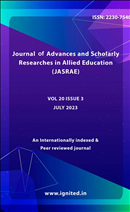Analyze and identify the patient safety culture and possible predictors and areas for improvement related to patient safety culture of Saudi Arabia
Keywords:
patient safety culture, predictors, areas for improvement, Saudi Arabia, healthcare qualityAbstract
Patient outcomes and the effectiveness of the healthcare system as a whole are substantiallyimpacted by patient safety culture, which is a crucial aspect of healthcare quality. This research analyzesand identifies Saudi Arabia's patient safety culture, along with potential predictors and areas fordevelopment. The present research is an electronic, cross-sectional, descriptive survey of communitypharmacy pharmacists. In accordance with recommendations made by the Agency for HealthcareResearch and Quality (AHRQ), the positive response rate (PRR) was determined. The findings of thepresent research suggest that there is room for improvement in patient safety across a number ofcommunity pharmacies. However, a high response rate must be taken into consideration whileprioritizing the necessity.References
Zwijnenberg, N.C.; Hendriks, M.; Hoogervorst-Schilp, J.; Wagner, C. Healthcare professionals’ views on feedback of a patient safety culture assessment. BMC Health Serv. Res. 2016, 16, 199.
Wagner, C.; Kristensen, S.; Soursa, P.; Panteli, D. Patient Safety Culture as a quality strategy. In Improving Healthcare Quality in Europe: Characteristics, Effectiveness and Implementation of Different Strategies; Busse, R., Klazinga, N., Panteli, D., Quentin, W., Eds.; World Health Organization and OECD: Copenhagen, Denmark, 2019; Chapter 11; pp. 287–308.
Lee, S.E.; Vincent, C.; Dahinten, V.S.; Scott, L.D.; Park, C.G.; Dunn Lopez, K. Effects of individual nurse and hospital characteristics on patient adverse events and quality of care: A multilevel analysis. J. Nurs. Scholarsh. 2018, 50, 432–440.
Lee, S.E.; Dahinten, V.S. The enabling, enacting, and elaborating factors of safety culture associated with patient safety: A multilevel analysis. J. Nurs. Scholarsh. 2020, 52, 544–552.
Saleh, A.M.; Darawad, M.W.; Al-Hussami, M. The perception of hospital safety culture and selected outcomes among nurses: An exploratory study. Nurs. Health Sci. 2015, 17, 339–346.
Huang, C.H.; Wu, H.H.; Lee, Y.C. The perceptions of patient safety culture: A difference between physicians and nurses in Taiwan. Appl. Nurs. Res. 2018, 40, 39–44.
Hao, H.S.; Gao, H.; Li, T.; Zhang, D. Assessment and comparison of patient safety culture among health-care providers in shenzhen hospitals. Risk Manag. Healthc. Policy 2020, 13, 1543–1552.
Alquwez, N.; Cruz, J.P.; Almoghairi, A.M.; Al-otaibi, R.S.; Almutairi, K.O.; Alicante, J.G.; Colet, P.C. Nurses’ perceptions of patient safety culture in three hospitals in Saudi Arabia. J. Nurs. Scholarsh. 2018, 50, 422–431.
Listyowardojo, T.A.; Nap, R.E.; Johnson, A. Variations in hospital worker perceptions of safety culture. Int. J. Qual. Health Care 2012, 24, 9–15.
Arrieta, A.; Suárez, G.; Hakim, G. Assessment of patient safety culture in private and public hospitals in Peru. Int. J. Qual. Health Care 2018, 30, 186–191.
Lee, S.E.; Quinn, B.L. Safety culture and patient safety outcomes in East Asia: A literature review. West. J. Nurs. Res. 2020, 42, 220–230.
Smits, M.; Wagner, C.; Spreeuwenberg, P.; Van Der Wal, G.; Groenewegen, P.P. Measuring patient safety culture: An assessment of the clustering of responses at unit level and hospital level. BMJ Qual. Saf. 2009, 18, 292–296.
Singer, S.J.; Vogus, T.J. Safety climate research: Taking stock and looking forward. BMJ Qual. Saf. 2013, 22, 1–4.
Jang, S.-J.; Lee, H.; Son, Y.-J. Perceptions of patient safety culture and medication error reporting among early- and mid-career female nurses in South Korea. Int. J. Environ. Res. 2021, 18, 4853.
Luchman, J.N. Determining subgroup difference importance with complex survey designs: An application of weighted dominance analysis. Survey Pract. 2015, 8. Available online: https://www.surveypractice.org/article/2835-determining-subgroup-difference-importance-with-complex-survey-designs-an-application-of-weighted-dominance-analysis (accessed on 10 July 2021).
Hakanen, J.J.; Bakker, A.B.; Turunen, J. The relative importance of various job resources for work engagement: A concurrent and follow-up dominance analysis. BRQ Bus. Res. Q. 2021.
Famolaro, T.; Yount, N.; Burns, W.; Flashner, E.; Liu, H.; Sorra, J. Hospital Survey on Patient Safety Culture 2016 User Comparative Database Report; (Prepared by Westat, Rockville, MD, under Contract No. HHSA 290201300003C); Agency for Healthcare Research and Quality: Rockville, MD, USA, 2016.
Sorra, J.S.; Dyer, N. Multilevel psychometric properties of the AHRQ hospital survey on patient safety culture. BMC Health Serv. Res. 2010, 10, 199.
Davis, K.K.; Harris, K.G.; Mahishi, V.; Bartholomew, E.G.; Kenward, K. Perceptions of culture of safety in hemodialysis centers. Nephrol. Nurs. J. 2016, 43, 119.
Calvache, J.A.; Benavides, E.; Echeverry, S.; Agredo, F.; Stolker, R.J.; Klimek, M. Psychometric properties of the Latin American Spanish version of the hospital survey on patient safety culture questionnaire in the surgical setting. J. Patient Saf. 2020.
Aiken, L.H.; Clarke, S.P.; Sloane, D.M.; Lake, E.T.; Cheney, T. Effects of hospital care environment on patient mortality and nurse outcomes. J. Nurs. Adm. 2008, 38, 223–229.
Azen, R.; Traxel, N. Using dominance analysis to determine predictor importance in logistic regression. J. Educ. Behav. Stat. 2009, 34, 319–347.
Budescu, D.V. Dominance analysis: A new approach to the problem of relative importance of predictors in multiple regression. Psychol. Bull. 1993, 114, 542–551.
El-Jardali, F.; Dimassi, H.; Jamal, D.; Jaafar, M.; Hemadeh, N. Predictors and outcomes of patient safety culture in hospitals. BMC Health Serv. Res. 2011, 11, 45.
Alenius, L.S.; Tishelman, C.; Runesdotter, S.; Lindqvist, R. Staffing and resource adequacy strongly related to RNs’ assessment of patient safety: A national study of RNs working in acute-care hospitals in Sweden. BMJ Qual. Saf. 2013, 23, 242–249.
Driesen, B.E.J.M.; Merten, H.; Wagner, C.; Bonjer, H.J.; Nanayakkara, P.W.B. Unplanned return presentations of older patients to the emergency department: A root cause analysis. BMC Geriatr. 2020, 20, 365.
Bates, D.W.; Singh, H. Two decades since to err is human: An assessment of progress and emerging priorities in patient safety. Health Aff. 2018, 37, 1736–1743.











